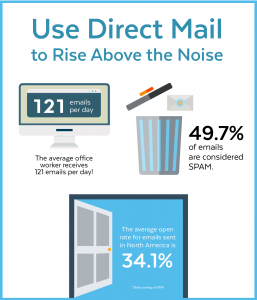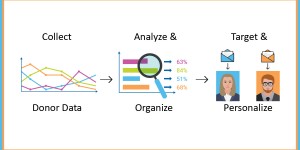We’ve talked a lot about how personalizing communication materials helps nonprofits build relationships with their donors. Now that we’ve touched on why your organization needs to personalize communications, general strategies for implementing versioned and variable content, and data’s role in the personalization process, it is time to explore some print specific personalization techniques, also known as variable data printing.
Before we really delve into print specifics, it is important to consider that print and digital communications can work together to drive better engagement and results. For example, you can use email to test what messaging resonates with your audience best. Email is also a great way to follow up on a direct mail appeal. We will get more into blending print and digital strategies in a later blog series focusing on integration.
Direct marketing through email is at an all-time high. Over-saturated inboxes have made it harder to make your message stand out above the noise. Therefore, the most successful nonprofit marketers and fundraisers use direct mail, in conjunction with digital strategies, to help their message rise above the clutter while adding a personal touch. This approach increases trust and offers an enhanced user experience.
Delivering a Unique Experience 
Even as we move into an increasingly digital world, direct mail is still the most effective method for fundraising. Data shows that direct mail still generates more donations than email and other digital fundraising strategies. Variable data printing helps fundraisers increase engagement and response rate and create an individualized experience for each donor.
Creating successful personalized communications requires a robust donor database. If you don’t know anything about the people you are communicating with, you can’t have a meaningful encounter with them. Having at least a bit of data on your targets is an essential first step. It will be much easier to craft individualized messaging once you have some information at your fingertips.
With data at your disposal, the opportunities to individualize print pieces are nearly limitless. Text, color, photos, illustrations and other graphics can all be tailored to meet individual needs. You can deliver a unique experience with each direct mail appeal starting with the mailing envelope. You can incorporate personalized and versioned elements, including images on postcards and reply cards from there. Images or copy on lift notes can reflect giving history. This is a chance to create relevance, so anything you can do to build a relationship will benefit you overall.
Variable Data Printing for Other Materials
Transactional documents, such as donation receipts, membership renewal statements, and endowment fund statements are primed for personalization. Your audience won’t be shaken by a customized message on these documents since are already personal in nature. Documents such as an endowment fund statement can include an annual fund ask or a heartfelt, non-generic thank you.
Brochures are another print material that you may not have thought of targeting on an individual basis. Personalized brochures are effective and efficient. They can be custom-fit to include programs and projects the prospective donor expressed interest in. Visual elements can be varied, including photos, infographics, and color schemes.
Cutting Down on Cost
The thought of designing, printing, and mailing thousands of direct mail pieces can make even the most financially stable nonprofits agonize about costs. Luckily, variable data printing can minimize expenses. Nonprofits can send out fewer, more effective pieces of mail since the materials of interest can be narrowed down to an individual or small group basis. Personalization will cut down on paper, printing, and postage costs, helping you maximize your return on investment.
So where should you focus direct mail efforts? It is a good idea to concentrate on recent donors, who are already looking forward to your next communication. Making recent donors the focus of a direct mail campaign helps build loyalty. Simple reminders, such as a well-designed postcard, will nudge engaged donors into action and keep your organization on their mind.
Frequent interactions with your highly engaged donors and frequent or high-volume contributors will help you figure out what your audience wants to hear. You can craft a more relevant message by identifying the concerns or motivations among your donors. By concentrating on those who are already engaging your organization, you will get a feel for how to target prospective donors who fit the same profile.
Modern communications need to get the right message to the right people. This technique is cost-efficient and generates better results than a spray and pray approach. Variable data printing will get your message to your ideal audience and help materials stand out above mass appeal communications.
How Does Variable Data Printing Work?
By now, we shouldn’t need to explain why personalization through variable data printing is so effective. There is no denying communications developed on an individual basis are more effective than the old school mass appeal strategy. However, it may benefit you to explain exactly how the process works.
Variable data printing is a digital printing method that pulls information from computerized databases, then applies it to personalize materials. As we have discussed, content tailored to individuals increases response rate and return on investment. You can track these metrics by incorporating personalized or generic campaign-specific landing pages and promotional codes into print materials. As more people visit their unique landing pages, you will be able to measure the impact of your direct mail campaign. However, for this to be effective, you need a way to individualize each piece of content while keeping costs down without slowing down the printing process.
This is where variable data printing comes in. You can easily swap out text and images as necessary when the process is applied with digital printing. You can apply data concerning a recipient’s giving history, age, and location. Digital printing makes this method even simpler. It is no longer necessary to create and replace for personalized content. Modern software allows the process to utilize small, efficient print files to maximize print speed. This makes personalization executed with digital printing and variable data printing much cheaper, faster, and easier.
Maximize Your ROI
Remember, replacing individual pieces of content based on data will appeal to each recipient and maximize your return on investment, as we discussed in our post covering variable and versioned personalization methods. Variable data printing is the most effective process to apply personalization to print materials. Be sure to check our blog next week for our overview of creating unique digital fundraising materials.





